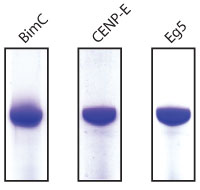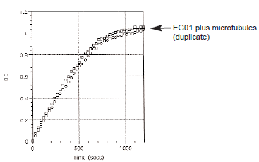Eg5 kinesin motor domain protein (KIF11): GST tagged: Homo sapiens recombinant
Product uses
- Measurement of microtubule-activated AT Pase activity
- Identification/characterization of proteins or small molecules that affect motor ATPase activity
- Identification/characterization of proteins or small molecules that affect kinesin motility
- Identification/characterization of proteins or small molecules that affect motor/microtubule interactions
Material
The conserved motor domain of human kinesin Eg5 (KIF11) was expressed in a prokaryotic system. The recombinant protein contains a GST-Tag at the amino terminal end and has a combined molecular weight of 74 kDa. The protein has been determined to be biologically active in a microtubule-activated ATPase activity test. The protein is supplied as a lyophilized powder.
Purity
Protein purity is determined by scanning densitometry of Coomassie Blue stained protein on a 12% polyacrylamide gel. All kinesin motor domains are >85% pure. See figure 1 for example purities.

Biological Activity - Microtubule Activated ATPase Assay
Eg5 ATPase activity was measured by monitoring real time free phosphate generation using the Kinesin ELIPA Assay Kit (Cat. # BK060). The assay is based upon an absorbance shift (330 nm to 360 nm) that occurs when 2-amino-6-mercapto-7-methylpurine ribonucleoside (MESG) is catalytically converted to 2-amino-6mercapto-7-methylpurine in the presence of inorganic phosphate (Pi). One molecule of Pi will yield one molecule of 2-amino-6mercapto-7-methylpurine in an essentially irreversible reaction. Hence, the absorbance at 360 nm is directly proportional to the amount of Pi generated in the kinesin ATPase reaction. Under the conditions outlined below, the Vmax for Eg5 microtubule-activated ATPase activity is >600 nmoles ATP generated per minute per mg of EG01 (Figure 2).

Figure 2. EG01 microtubule-activated ATPase activity using the Kinesin ELIPA Assay Kit (Cat. # BK060). Eg5 ATPase activity was assayed in duplicate according to the method described. Control reactions were carried out in the absence of motor protein and in the absence of microtubules, both control reactions gave negligible ATPase activity (data not shown).
For product Datasheets and MSDSs please click on the PDF links below. For additional information, click on the FAQs tab above or contact our Technical Support department at tservice@cytoskeleton.com
Question 1: What is the minimum concentration this kinesin motor protein can be stored at?
Answer 1: For storage at -70°C, the protein concentration should not be less than 5 mg/ml. Kinesin diluted below 5 mg/ml should not be re-frozen as it will lose activity.
Question 2: What is the most common use of this motor domain protein?
Answer 2: The Eg5 motor domain protein is most commonly used in conjunction with microtubules to measure microtubule-stimulated Eg5 ATPase activity. The ATPase activity can be measured with an endpoint or kinetic assay. Other uses of this motor protein include identification/characterization of proteins or small molecules that affect motor ATPase activity and identification/characterization of proteins or small molecules that affect motor/microtubule interactions.
If you have any questions concerning this product, please contact our Technical Service department at tservice@cytoskeleton.com








